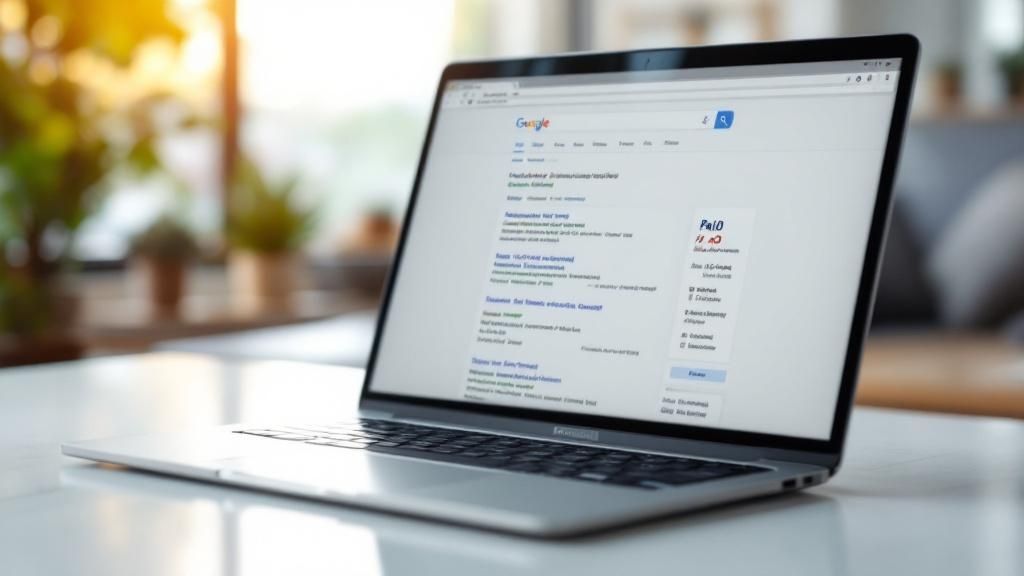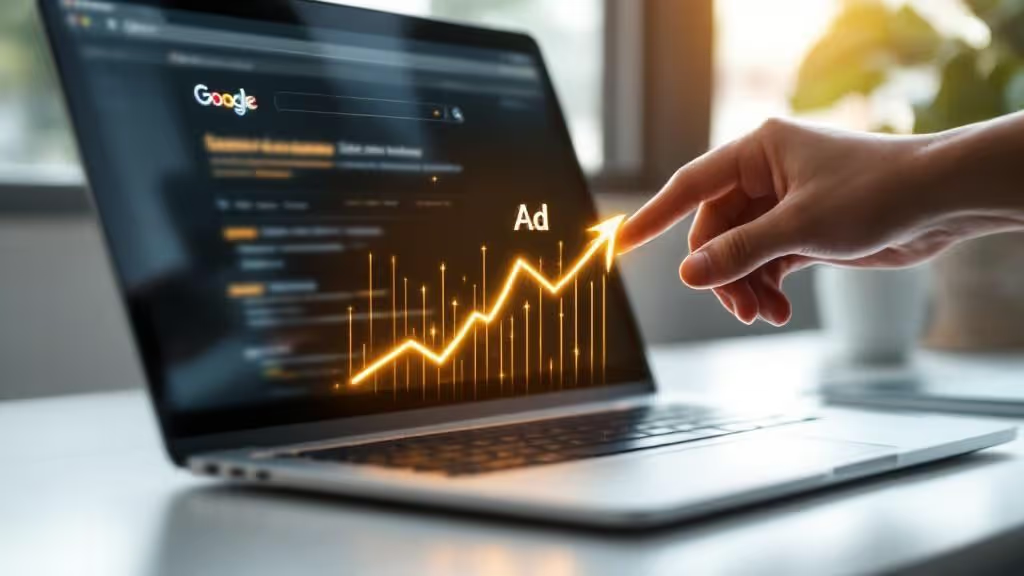Paid search advertising is a powerful form of digital marketing where businesses pay to have their ads displayed at the top of search engine results. The concept is straightforward: you place your ads precisely where potential customers are actively searching for your products or services, capturing their attention at the exact moment of intent.
A First Look at Paid Search Advertising

Imagine a vast digital marketplace where millions of consumers are clearly stating their needs and wants. This is the essence of paid search. It’s not about interrupting a user's browsing experience; it’s about providing a relevant solution at the moment they have explicitly indicated interest.
This process is powered by a real-time bidding system known as the ad auction. However, it's not a simple case of the highest bidder winning. Search engines like Google and Microsoft employ sophisticated algorithms that evaluate your bid alongside the quality and relevance of your advertisement. A well-crafted ad with a modest bid can often outperform a generic ad with a large budget.
To fully grasp how paid search works, it's helpful to view it as a complete system with several key components. Here’s a brief overview to provide a foundational understanding.
Paid Search Advertising at a Glance
Now that you have the high-level view, let's explore the specific elements that drive this powerful marketing channel.
Key Components of the Ecosystem
To effectively leverage paid search, you must understand its core building blocks. These fundamental elements work in concert to connect your business with the right audience.
- Keywords: These are the search terms users type into a search engine. As an advertiser, you select and bid on keywords that are relevant to your business, which triggers your ads to appear.
- Ad Auction: Each time a user searches for one of your chosen keywords, an auction occurs in milliseconds. The search engine determines which ads to display and in what order for that specific query.
- Ad Rank: This metric determines your ad's position on the search results page. It is calculated based on a combination of your bid amount, the quality of your ad and landing page, and the expected impact of ad extensions.
- Cost-Per-Click (CPC): This is the most prevalent payment model. You are not charged for your ad simply appearing (an impression); you only pay the "cost-per-click" when a user actually clicks on your ad to visit your site.
Paid search prioritizes relevance over budget alone. By carefully selecting keywords and crafting compelling ads, you ensure your message connects with an audience that is actively seeking solutions, not just browsing.
This direct, intent-driven approach has become a cornerstone of modern digital marketing for a simple reason—it delivers results. Its effectiveness is so well-established that an estimated 80% of businesses use pay-per-click (PPC) advertising to attract new customers and drive growth. You can discover more insights about PPC statistics to see the full scope of its impact.
How the Paid Search Auction Actually Works
The term "auction" might evoke images of a room where the highest bidder wins. In paid search, the process is more nuanced. It operates less like a traditional auction and more like a juried competition, where the best all-around entry earns the top prize.
Every time a user enters a search query, a rapid, behind-the-scenes auction is initiated to determine which ads will be displayed and in what order. This system is designed to ensure users see helpful, high-quality advertisements, maintaining the integrity and utility of the search results. Platforms like Google rely on this to keep their user experience trustworthy.
The Role of Ad Rank and Quality Score
How is the "winner" of the auction determined? Your ad's position is dictated by a metric called Ad Rank. Think of it as your final score in the auction. The formula is a multiplication of your maximum bid (the most you’re willing to pay for a click) and your Quality Score.
A higher Ad Rank not only secures a better ad position but can also lead to a lower cost-per-click. This is where your Quality Score becomes a critical strategic asset. It’s a rating from 1 to 10 assigned by the search engine based on the quality of your ad, keyword, and landing page. A high score signals that your ad is a strong match for the user's query, which can result in significant cost savings and premium ad placements.
The core principle is straightforward: search engines reward advertisers who enhance the user experience. A high Quality Score is tangible proof that you are delivering relevant, helpful content, allowing you to secure top ad positions without simply outbidding the competition.
Breaking Down the Quality Score Components
Your Quality Score is not an arbitrary number. It’s an aggregate metric based on several key factors that collectively assess your ad's overall quality and relevance. Understanding these components is the first step toward optimizing your campaigns.
- Expected Click-Through Rate (CTR): This is the search engine's prediction of how frequently users will click your ad when it is shown. It serves as a direct measure of how well your ad resonates with searcher intent.
- Ad Relevance: This component evaluates how closely your ad copy aligns with the user's search query. For a query like "emergency IT support," an ad headline promoting "24/7 Tech Help" will be far more relevant than a generic ad for "IT Services."
- Landing Page Experience: After a user clicks your ad, their experience on your landing page is evaluated. Is the page useful and relevant? Does it load quickly and navigate easily? Crucially, does it deliver on the promise made in your ad?
This visual illustrates the flow from a user's initial search to the final ad they see on the results page.

As you can see, the auction is the pivotal step, constantly balancing user intent with advertiser offerings. By improving each of the Quality Score components, you gain a significant advantage in every auction you enter. For businesses in specialized sectors like managed services, mastering this is essential. You can explore this topic further in our guide on how to run Google Ads for MSP services.
Navigating the Modern Paid Search Landscape

While Google Ads is the dominant force in paid search, it is just one part of a much broader ecosystem. Concentrating your entire budget on Google is akin to fishing in only one part of a vast ocean—you miss countless other areas where your target audience may be active.
A diversified approach is essential for comprehensive market coverage. The paid search, or pay-per-click (PPC), industry is a global powerhouse. Worldwide spending is projected to reach $351.55 billion by 2025, with the U.S. market alone accounting for $140.06 billion. You can find more detailed PPC statistics here to appreciate the scale of this channel.
These figures underscore a critical point: a single-channel strategy is no longer sufficient. This is where a deep understanding of what paid search advertising is becomes a significant competitive advantage.
Comparing the Major Paid Search Platforms
Each advertising platform serves a unique audience and possesses distinct characteristics. The key to success is aligning the platform's strengths with your specific business goals and target demographic.
- Google Ads: As the undisputed market leader, Google handles the vast majority of global search queries. It is the premier platform for reaching a massive audience that is actively seeking information and solutions.
- Microsoft Advertising: Often overlooked, Microsoft's ad network (which includes Bing and Yahoo) reaches a distinct and valuable demographic, frequently comprising more mature and affluent users. It can be particularly effective for B2B campaigns, as its audience often consists of professionals searching from their workplace devices.
- Amazon Ads: For businesses selling physical products, advertising on Amazon is indispensable. It functions as a high-intent search engine where every user is a potential buyer. This platform is ideal for capturing customers at the final stage of the purchasing journey.
A diversified paid search strategy is not just about expanding your reach; it’s about building campaign resilience. By distributing your budget across multiple platforms, you mitigate the risk of being overly dependent on a single company's algorithm. Furthermore, you can often find lower costs-per-click and less competition on alternative platforms.
The Rise of Niche and Social Search
Beyond the major platforms, the landscape is continually evolving. Social networking sites are transforming into powerful search and discovery engines, particularly for younger demographics.
Consider TikTok Search, which has rapidly become a primary search tool for Gen Z users seeking product recommendations, authentic reviews, and instructional content. Ignoring these emerging search behaviors means overlooking an entire generation of potential customers.
An effective strategy involves meeting your audience wherever they seek answers—not just on the platforms you assume they use.
How to Pay for Ads and Measure Success
Executing a paid search campaign without a clear understanding of its financial performance is like navigating without a compass. To optimize your strategy, you must know how your budget is being spent and what returns you are generating.
This process begins with selecting the appropriate pricing model, which directly influences your strategy and determines whether you pay for clicks, impressions, or specific actions.
The Most Common Ways to Pay for Search Ads
Think of these pricing models as different tools for different objectives. Your choice should align directly with your campaign goals to ensure maximum efficiency.
Here are the most common pricing models and their primary applications.
Comparing Paid Search Pricing Models
Ultimately, your campaign goal dictates the optimal model. CPC is ideal for generating traffic, CPM excels at building brand recognition, and CPA is designed for precision-focused conversion campaigns.
Key Metrics: The Health-Check for Your Campaigns
Once your ads are live, you must monitor several key metrics to evaluate performance. These Key Performance Indicators (KPIs) provide insights into what resonates with your audience and what needs to be improvement.
Here are the essential metrics that every paid search professional monitors:
- Click-Through Rate (CTR): The percentage of users who click your ad after seeing it. A high CTR indicates that your ad copy and targeting are compelling and relevant. A low CTR suggests a disconnect that needs to be addressed.
- Conversion Rate: The percentage of users who complete a desired action (e.g., a purchase or signup) after clicking your ad. This metric measures the effectiveness of your landing page in converting visitors into customers.
- Return on Ad Spend (ROAS): The ultimate measure of profitability. ROAS calculates the revenue generated for every dollar spent on advertising. A high ROAS signifies a successful and profitable campaign.
Of course, a crucial part of managing ad spend is preventing payment for clicks that are unlikely to convert. To achieve this, you must strategically filter out irrelevant searches. A great starting point is learning what are negative keywords and how they can significantly improve budget efficiency.
Proven Strategies for a Winning Campaign
Theoretical knowledge is valuable, but successful paid search campaigns are built on practical application. A great campaign is not a matter of luck; it is the outcome of deliberate, strategic actions designed to connect with your audience and drive them to act.
The foundation of any successful campaign is a deep understanding of your customer. You must know who you are trying to reach and what phrases they use when searching online.
This process starts with thorough SEO keyword research. This goes beyond simply guessing search terms; it involves using data to uncover the exact phrases your potential customers use when they are actively seeking your solution.
Tools like Google Keyword Planner and Semrush are indispensable for this task. They help you identify high-intent keywords that signal a user is ready to make a purchase, not just browse.
Crafting Ads That Demand Attention
Once you have identified your target keywords, the next step is to write ad copy that stands out on a crowded search results page. Your ad serves as your digital storefront—it must be compelling enough to capture attention and encourage a click.
A winning ad includes several essential ingredients:
- A Clear Value Proposition: Why should a user choose you? Lead with a powerful benefit that differentiates you from the competition.
- Echo the Keyword: Your ad copy should directly address the user's search query, confirming its relevance.
- A Strong Call-to-Action (CTA): Be direct. Instruct users on the next step with phrases like "Shop Now," "Get a Free Quote," or "Download Our Guide."
Beyond the text, ad extensions are a powerful tool for enhancing visibility and performance. These are additional pieces of information—such as your phone number, address, or links to specific site pages—that make your ad larger and more informative. Using them is a simple yet effective way to boost your click-through rate.
Optimizing the Post-Click Experience
Securing the click is only half the battle. If your landing page fails to deliver on the promise of your ad, you have wasted your investment. A high-converting landing page is clean, loads quickly, and is focused on a single, clear objective.
The user journey from ad to landing page must be seamless. If a user clicks an ad for "emergency plumbing services," they should arrive on a page dedicated to that specific service, not your company's homepage. This alignment is critical for maintaining a high Quality Score and, more importantly, for converting visitors into customers.
Finally, to maximize budget efficiency, you must utilize negative keywords. These are terms you instruct the ad platform not to show your ads for.
For example, a luxury car dealership would add terms like "cheap" and "used" to its negative keyword list to filter out clicks from unqualified prospects. This simple step ensures your ad spend is directed only toward relevant searches, significantly improving your campaign’s return on investment.





